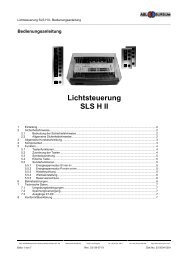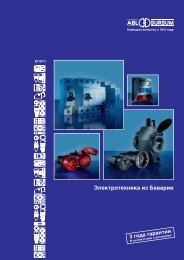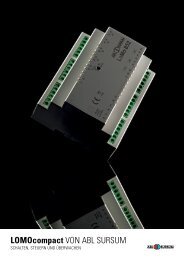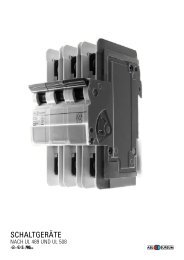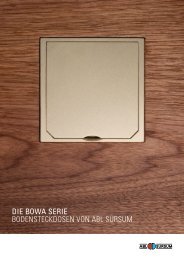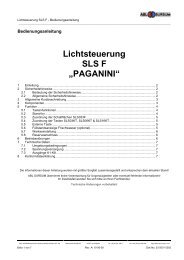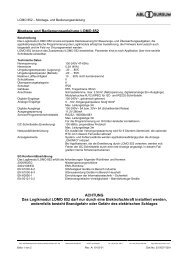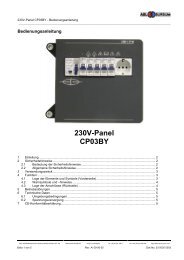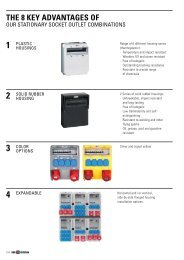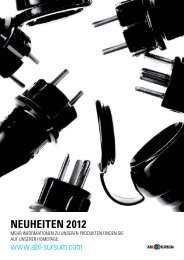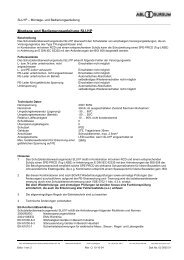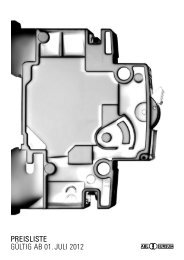PROTECTION - ABL Sursum
PROTECTION - ABL Sursum
PROTECTION - ABL Sursum
Create successful ePaper yourself
Turn your PDF publications into a flip-book with our unique Google optimized e-Paper software.
RESIDUAL CURRENT CIRCUIT BREAKERS<br />
General explanations<br />
Additional protection in case of direct contact according<br />
to vDe 0100-410 (operator protection)<br />
By using high-sensitivity RCDs with a rated residual current of<br />
I�n ≤ 30 mA, additional protection in case of direct contact with<br />
an (unearthed) part conducting voltage is achieved (see Figure 2).<br />
This additional protection is necessary if<br />
· The insulation of totally-insulated devices or a feed cable<br />
is damaged,<br />
· The protective conductor is interrupted,<br />
· The protective and active conductor got mixed up and conductive<br />
parts which are normally earthed are thus energised, or<br />
· There is contact with a part which is energised under normal<br />
operating conditions during repair work.<br />
Based on this extended protection scope, the vDE set of standard<br />
specifications stipulates the use of a residual current<br />
circuit breaker according to vDE 0664-10 or an RCBO according<br />
Fire protection<br />
Effective protection against fires caused by earth faults can<br />
even be achieved with relatively insensitive RCDs (l�n ≤ 300<br />
mA). For earth residual currents ≤ 300 mA, the electric power<br />
transferred at the fault location is normally not sufficient to<br />
ignite standard flammable materials.<br />
Although ignition is possible for higher residual currents<br />
because of the power, the RCD switches off the power supply<br />
in less than 0.3 seconds and thus limits the electric ignition<br />
power to harmless values.<br />
RCDs for fault protection, operator protection and fire protection<br />
According to vDE 0100-530 (construction of non-voltage systems<br />
- part 530: selecting and setting up electrical equipment, switchgears<br />
and control gears), the following RCDs can be used for the<br />
protection targets mentioned above:<br />
· Residual current circuit breakers according to DIN EN 61008-1<br />
vDE 0664-10 Abbreviation: RCCb (Residual Current Circuit<br />
breaker without integral overcurrent protection)<br />
· RCBOs according to DIN EN 61009-1 vDE 0664-20 Abbreviation:<br />
RCbO (Residual Current Circuit breaker with integral<br />
Overcurrent Protection)<br />
· Circuit breakers with residual current trip according to<br />
DIN EN 60947-2 vDE 660-101 Appendix B Abbreviation: CbR<br />
58<br />
to vDE 0664-20 with I�n ≤ 30 mA for the construction of<br />
systems in areas that are particularly accident-prone.<br />
This applies to, for example,<br />
· Outlet circuits in rooms with a bath tub or a shower<br />
(vDE 0100-701)<br />
· Caravans, boats and yachts as well as their power<br />
supplies at camping sites or moorings (vDE 0100-721)<br />
· Rooms used for medical purposes (vDE 0107).<br />
By no means must this additional protection be considered<br />
a basic protection measure since the residual current<br />
flows through the human body into the earth in case of direct<br />
contact. It is rather an “emergency brake” for the fault<br />
events mentioned above. According to vDE 0100-530, only<br />
RCDs as described in the section “RCDs for fault protec -<br />
tion, operator protection and fire protection” on the right side<br />
may be used for additional protection.<br />
I<br />
System earth<br />
figure 2<br />
I<br />
RCCBs<br />
I<br />
Rm<br />
Resistance of<br />
the human<br />
body<br />
U<br />
I =<br />
RM + RSt<br />
RSt<br />
local resistance<br />
(Circuit breaker providing Residual current protection)<br />
· Modular Residual Current Protective Devices (abbreviation:<br />
MRCD) according to DIN EN 60947-2 vDE 0660-101<br />
Appendix M whose units for measuring differential current<br />
(trans formers), assessing differential current (differential<br />
current relays) and the load switch unit are accommodated<br />
in separated enclosures can be used in systems that are<br />
operated and, on a regular basis, maintained by people with<br />
electrotechnical expertise.<br />
In systems where it is not possible to install the devices<br />
mentioned above – e.g. because an instant switch-off means<br />
endangering people or creating a lot of material damage –<br />
RCM differential current monitoring devices (abbreviation for<br />
Residual Current Monitor) according to DIN EN 62020 vDE<br />
0662 can be used.<br />
L1<br />
L2<br />
L3<br />
n



